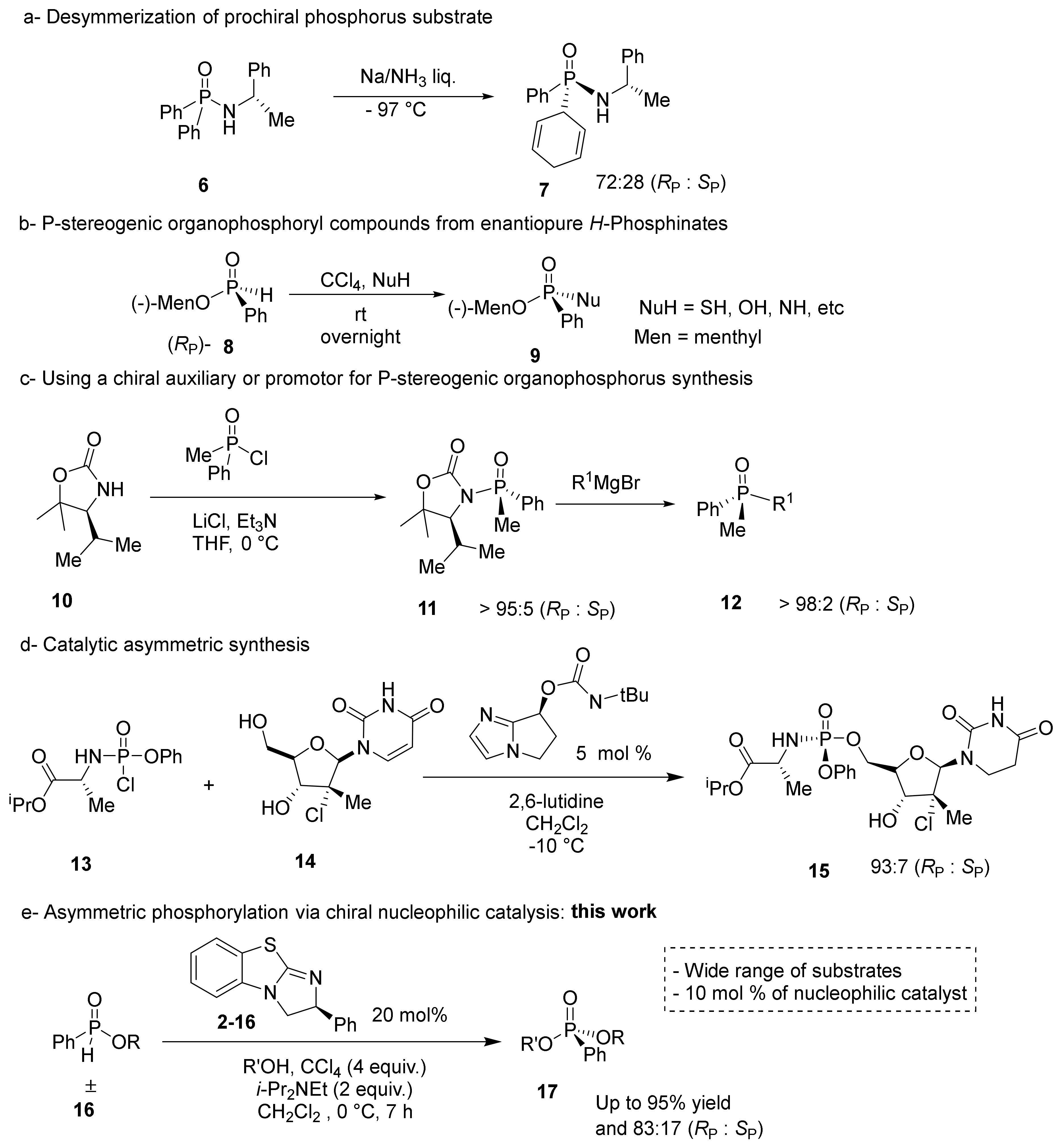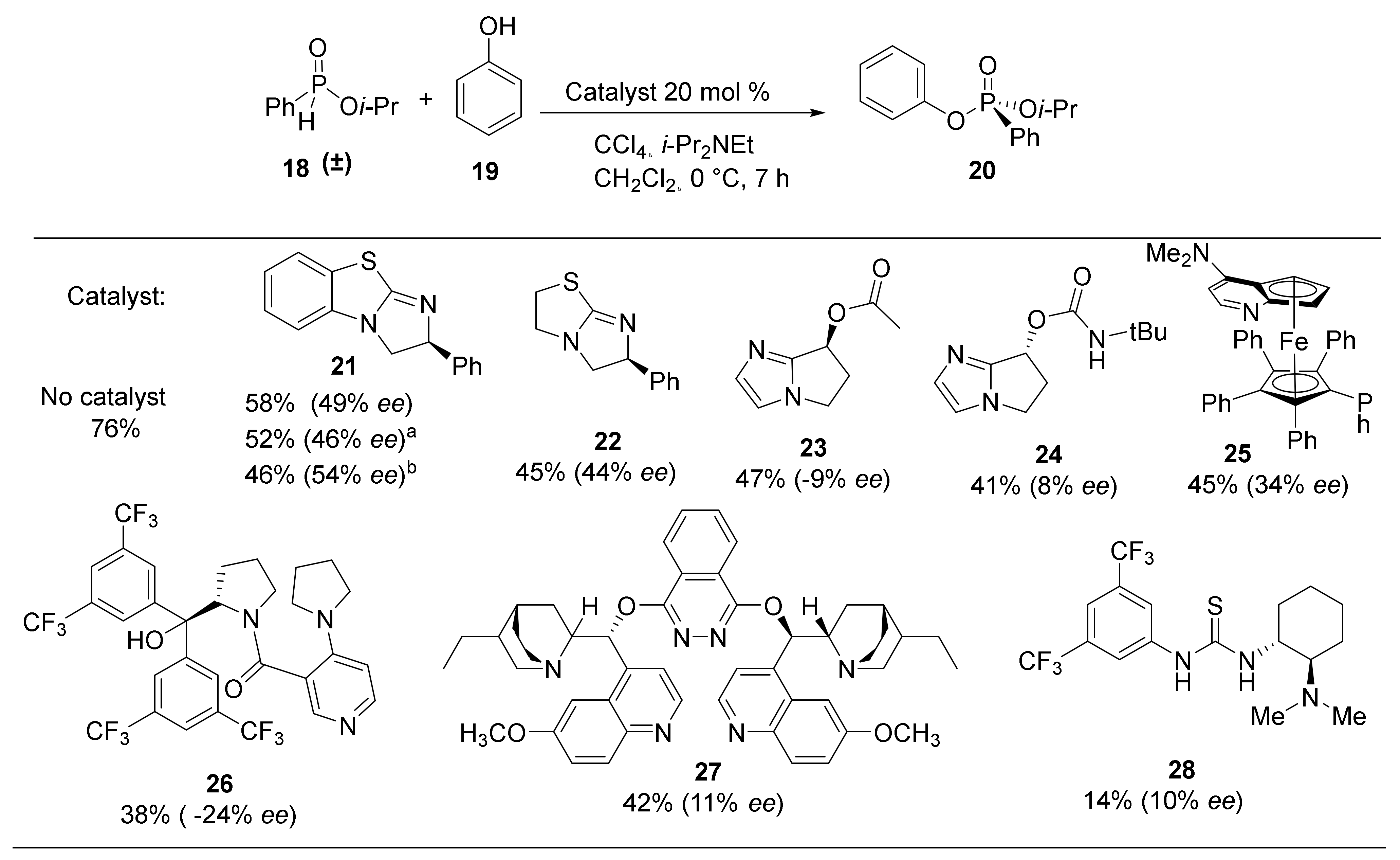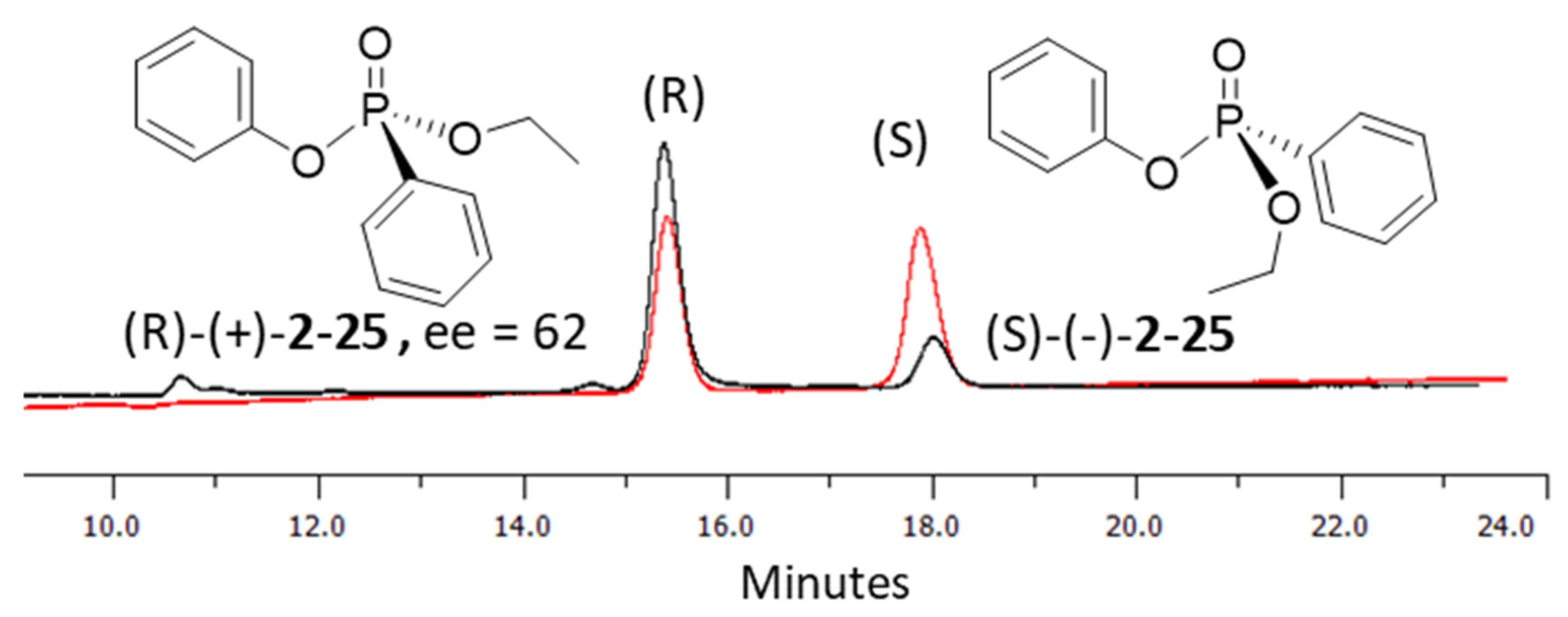Asymmetric Synthesis of Stereogenic Phosphorus P(V) Centers Using Chiral Nucleophilic Catalysis
Abstract
:1. Introduction
2. Results and Discussion
3. Materials and Methods
General Information
4. Conclusions
Supplementary Materials
Author Contributions
Funding
Institutional Review Board Statement
Informed Consent Statement
Data Availability Statement
Acknowledgments
Conflicts of Interest
Sample Availability
References
- Hara, I.R.; Saito, T.; Kogure, T.; Hamamura, Y.; Uchiyama, N.; Nukaga, Y.; Iwamoto, N.; Wada, T. Stereocontrolled Synthesis of Boranophosphate DNA by an Oxazaphospholidine Approach and Evaluation of Its Properties. J. Org. Chem. 2019, 84, 7971–7983. [Google Scholar] [CrossRef]
- Sharma, V.; Sharma, S.; Singh, S. Antisense oligonucleotides: Modifications and clinical trials. Med. Chem. Commun. 2014, 5, 1454–1471. [Google Scholar] [CrossRef]
- Carrasco, N.; Caton-Williams, J.; Brandt, G.; Wang, S.; Huang, Z. Efficient enzymatic synthesis of phosphoroselenoate RNA by using adenosine 5′-(α-P-seleno)triphosphate. Angew. Chem. Int. Ed. 2005, 45, 94–97. [Google Scholar] [CrossRef]
- Gao, B.; Zhao, S.; Zhang, Z.; Li, L.; Hu, K.; Kaziem, A.E.; He, Z.; Hua, X.; Shi, H.; Wang, M. A potential biomarker of isofenphos-methyl in humans: A chiral view. Environ. Int. 2019, 127, 694–703. [Google Scholar] [CrossRef] [PubMed]
- Jia, M.; Wang, Y.; Teng, M.; Wang, D.; Yan, J.; Miao, J.; Zhou, Z.; Zhu, W. Toxicity and metabolomics study of isocarbophos in adult zebrafish (Danio rerio). Ecotoxicol. Environ. Saf. 2018, 163, 1–6. [Google Scholar] [CrossRef] [PubMed]
- Gill, J.P.K.; Sethi, N.; Mohan, A.; Datta, S.; Girdhar, M. Glyphosate toxicity for animals. Environ. Chem. Lett. 2018, 16, 401–426. [Google Scholar] [CrossRef]
- Zhang, L.; Miao, Y.; Lin, C. Enantiomeric separation of six chiral pesticides that contain chiral sulfur/phosphorus atoms by supercritical fluid chromatography. J. Sep. Sci. 2018, 41, 1460–1470. [Google Scholar] [CrossRef]
- Levchik, S. Phosphorus-Based FRs. In Non-Halogenated Flame Retardant Handbook, 1st ed.; Morgan, B., Wilkie, A., Eds.; Scrivener Publishing: Beverly, MA, USA, 2014. [Google Scholar]
- Dutartre, M.; Bayardon, J.; Jugé, S. Applications and stereoselective syntheses of P-chirogenic phosphorus compounds. Chem. Soc. Rev. 2016, 45, 5771–5794. [Google Scholar] [CrossRef]
- Li, W.; Zhang, X. Chiral Phosphines and Diphosphines. In Phosphorus(III) Ligands in Homogeneous Catalysis: Design and Synthesis, 1st ed.; Kamer, P., Van Leeuwen, P., Eds.; John Wiley & Sons, Ltd. Publication: New York, NY, USA, 2012. [Google Scholar]
- Rémond, E.; Bayardon, J.; Ondel-Eymin, M.; Jugé, S. Stereoselective synthesis of unsaturated and functionalized L-NHBoc amino acids, using wittig reaction under mild phase-transfer conditions. J. Org. Chem. 2012, 77, 7579–7587. [Google Scholar] [CrossRef] [PubMed]
- Kleineweischede, R.; Hackenberger, C. Chemoselective peptide cyclization by traceless staudinger ligation. Angew. Chem. Int. Ed. 2008, 47, 5984–5988. [Google Scholar] [CrossRef]
- Lacour, J.; Linder, D. Hexacoordinated phosphates: How to teach old chiral anions new asymmetric tricks. Chem. Rec. 2007, 7, 275–285. [Google Scholar] [CrossRef] [PubMed]
- Park, A.; Kim, S.; Park, J.; Joe, S.; Min, B.; Oh, J.; Song, J.; Park, S.; Park, S.; Lee, H. Structural and experimental evidence for the enantiomeric recognition toward a bulky sec-alcohol by Candida antarctica lipase B. ACS Catal. 2016, 6, 7458–7465. [Google Scholar] [CrossRef]
- Xu, G.; Senanayake, C.; Tang, W. P-Chiral Phosphorus Ligands Based on a 2,3-Dihydrobenzo[d][1,3]oxaphosphole Motif for Asymmetric Catalysis. Acc. Chem. Res. 2019, 52, 1101–1112. [Google Scholar] [CrossRef] [PubMed]
- Huang, H.; Denne, J.; Yang, C.H.; Wang, H.; Kang, J.Y. Direct Aryloxylation/Alkyloxylation of Dialkyl Phosphonates for the Synthesis of Mixed Phosphonates. Angew. Chem. Int. Ed. 2018, 57, 6624–6628. [Google Scholar] [CrossRef] [PubMed]
- Gurav, B.; Srinivasan, G. Antisense oligonucleotides as therapeutics and their delivery. Curr. Sci. 2017, 112, 490–498. [Google Scholar] [CrossRef]
- Li, J.; Eastgate, M. Current complexity: A tool for assessing the complexity of organic molecules. Org. Biomol. Chem. 2015, 13, 7164–7176. [Google Scholar] [CrossRef]
- Wan, B.W.; Seth, P.P. The Medicinal Chemistry of Therapeutic Oligonucleotides. J. Med. Chem. 2016, 59, 9645–9667. [Google Scholar] [CrossRef] [PubMed]
- Iwamoto, N.; Butler, D.; Svrzikapa, N.; Mohapatra, S.; Zlatev, I.; Sah, D.M.; Standley, S.; Lu, G.; Apponi, L.; Frank-Kamenetsky, M.; et al. Control of phosphorothioate stereochemistry substantially increases the efficacy of antisense oligonucleotides. Nat. Biotechnol. 2017, 35, 845–851. [Google Scholar] [CrossRef] [PubMed]
- Tomaszewska-Antczak, A.; Jastrzębska, K.; Maciaszek, A.; Mikolajczyk, B.; Guga, P. P-Stereodefined phosphorothioate analogs of glycol nucleic acids—synthesis and structural properties. RSC Adv. 2018, 8, 24942–24952. [Google Scholar] [CrossRef] [Green Version]
- Stankevič, M. Diastereoselective desymmetrization of diarylphosphinous acid-borane amides under Birch reduction. Org. Biomol. Chem. 2015, 13, 6082–6102. [Google Scholar] [CrossRef]
- Chen, T.; Han, L.B. Optically active H-phosphinates and their stereospecific transformations into optically active P-stereogenic organophosphoryl compounds. Synlett 2015, 26, 1153–1163. [Google Scholar] [CrossRef]
- Adams, H.; Collins, R.C.; Jones, S.; Warner, C.J.A. Enantioselective preparation of P-chiral phosphine oxides. Org. Lett. 2011, 13, 6576–6579. [Google Scholar] [CrossRef]
- Jordan, P.; Kayser-Bricker, K.; Miller, S. Asymmetric phosphorylation through catalytic P(III) phosphoramidite transfer: Enantioselective synthesis of D-myo-inositol-6-phosphate. Proc. Natl. Acad. Sci. USA 2010, 107, 20620–20624. [Google Scholar] [CrossRef] [Green Version]
- Ryan, M.; Liu, T.; Dahlquist, F.W.; Griffith, O.H. A catalytic diad involved in substrate-assisted catalysis: NMR study of hydrogen bonding and dynamics at the active site of phosphatidylinositol-specific phospholipase C. Biochemistry 2001, 40, 9743–9750. [Google Scholar] [CrossRef]
- Lee, L.; Lee, Y.; Leu, R.; Shaw, J. Functional role of catalytic triad and oxyanion hole-forming residues on enzyme activity of Escherichia coli thioesterase I/protease I/phospholipase L 1. Biochem. J. 2006, 397, 69–76. [Google Scholar] [CrossRef] [Green Version]
- DiRocco, D.; Ji, Y.; Sherer, E.; Klapars, A.; Reibarkh, M.; Dropinski, J.; Mathew, R.; Maligres, P.; Hyde, A.; Campeau, L.; et al. A multifunctional catalyst that stereoselectively assembles prodrugs. Science 2017, 356, 426–430. [Google Scholar] [CrossRef] [PubMed]
- Miller, P.; Annan, N.; McFarland, K.; Pulford, S. Oligothymidylate Analogues Having Stereoregular, Alternating Methylphosphonate/Phosphodiester Backbones as Primers for DNA Polymerase. Biochemistry 1982, 21, 2507–2512. [Google Scholar] [CrossRef] [PubMed]
- Koizumi, T.; Amitanti, H.; Yoshii, E. A New Method of Preparing Optically Active Alkyl Phenyl Phosphonates. Tetrahedron Lett. 1978, 39, 3741–3742. [Google Scholar] [CrossRef]
- Oka, N.; Wada, T. Stereocontrolled synthesis of oligonucleotide analogs containing chiral internucleotidic phosphorus atoms. Chem. Soc. Rev. 2011, 40, 5829–5843. [Google Scholar] [CrossRef] [PubMed]
- Wagner, P.; Leavitt, R.A. With LAH Stereospecific Alkylation of Menthyl Sir: Diastereomerically enriched menthyl phosphinates. J. Am. Chem. Soc. 1970, 5808–5809. [Google Scholar]
- Volle, J.; Filippini, D.; Midrier, C.; Sobecki, M.; Drag, M.; Virieux, D.; Pirat, J. Revisited synthesis of aryl-H-phosphinates. Synthesis 2011, 15, 2490–2494. [Google Scholar] [CrossRef]
- Volle, J.N.; Filippini, D.; Krawczy, B.; Kaloyanov, N.; Van Der Lee, A.; Maurice, T.; Pirat, J.L.; Virieux, D. Drug discovery: Phosphinolactone, in vivo bioisostere of the lactol group. Org. Biomol. Chem. 2010, 8, 1438–1444. [Google Scholar] [CrossRef] [PubMed]
- Iwamoto, N.; Oka, N.; Sato, T.; Wada, T. Stereocontrolled solid-phase synthesis of oligonucleoside H-phosphonates by an oxazaphospholidine approach. Angew. Chem. Int. Ed. 2009, 48, 496–499. [Google Scholar] [CrossRef]
- Evans, J.W.; Fierman, M.B.; Miller, S.J.; Ellman, J.A. Catalytic enantioselective synthesis of sulfinate esters through the dynamic Resolution of tert-butanesulfinyl chloride. J. Am. Chem. Soc. 2004, 126, 8134–8135. [Google Scholar] [CrossRef]
- Birman, B.V.; Li, X. Benzotetramisole: A remarkably enantioselective acyl transfer catalyst. Org. Lett. 2006, 8, 1351–1354. [Google Scholar] [CrossRef] [PubMed]
- McLaughlin, C.; Smith, A. Generation and Reactivity of C(1)-Ammonium Enolates by Using Isothiourea Catalysis. Chem. Eur. J. 2021, 27, 1533–1555. [Google Scholar] [CrossRef]
- Wu, J.; Young, C.; Smith, A. Isothiourea-catalysed transfer hydrogenation of a,b-unsaturated para- nitrophenyl esters. Tetrahedron 2021, 78, 131758. [Google Scholar] [CrossRef]
- Henderson, R.K.; Hill, A.P.; Redman, A.M.; Sneddon, H.F. Development of GSK’s acid and base selection guides. Green Chem. 2015, 17, 945–949. [Google Scholar] [CrossRef]
- Benoit, R.L.; Lefebvre, D.; Frechette, M. Basicity of 1,8-bis(dimethylamino)naphthalene and 1,4-diazabicyclo[2.2.2]octane in water and dimethyl sulfoxide. Can. J. Chem. 1987, 65, 996–1001. [Google Scholar] [CrossRef]
- Kreevoy, M.M.; Wang, Y. Kinetic and equilibrium acid-base behavior of tertiary amines in anhydrous and moist dimethyl sulfoxide. J. Phys. Chem. 1977, 81, 1924–1928. [Google Scholar] [CrossRef]
- Benoit, R.L.; Fréchette, M.; Lefebvre, D. 2,6-Di-tert-butylpyridine: An unusually weak base in dimethylsulfoxide. Can. J. Chem. 1988, 66, 1159–1162. [Google Scholar] [CrossRef] [Green Version]
- Otsuki, T.; Okamoto, Y.; Sakurai, H. Convenient procedure for the preparation of optically active phosphonates using the chirality of (S)-(−)alfa-methylbezylamine. Synthesis 1981, 10, 811–813. [Google Scholar] [CrossRef]
- Hall, C.R.; Williams, N.E. 1,3,2-Thiazaphospholidin-2-ones Derived From Ephedrine. Preparation and Stereochemistry of Ring-opening Reactions. J. Chem. Soc. Perkin Trans. 1981, 1, 2746–2750. [Google Scholar] [CrossRef]
- Mitova, V.; Koseva, N.; Troev, K. Study on the Atherton-Todd reaction mechanism. RSC Adv. 2014, 4, 64733–64736. [Google Scholar] [CrossRef]
- Nemeth, G.; Greff, Z.; Sipos, A.; Varga, Z.; Szekely, R.; Sebestyen, M.; Jaszay, Z.; Beni, S.; Nemes, Z.; Pirat, J.; et al. Synthesis and Evaluation of Phosphorus Containing, Specific CDK9/CycT1 Inhibitors. J. Med. Chem. 2014, 57, 3939–3965. [Google Scholar] [CrossRef]
- Kolodiazhnyi, O.I.; Kolodiazhna, A. Nucleophilic substitution at phosphorus: Stereochemistry and mechanisms. Tetrahedron Asymmetry 2017, 28, 1651–1674. [Google Scholar] [CrossRef]
- Kiss, N.Z.; Ludányi, K.; Drahos, L.; Keglevich, G. Novel synthesis of phosphinates by the microwave-assisted esterification of phosphinic acids. Synth. Commun. 2009, 39, 2392–2404. [Google Scholar] [CrossRef]
- Szelke, H.; Kovács, J.; Keglevich, G. Synthesis of H-phosphinates by the UV light—Mediated fragmentation- related phosphorylation using simple P-heterocycles. Synth. Commun. 2005, 35, 2927–2934. [Google Scholar] [CrossRef]






| Entry a | Base | *pKa in DMSO | Yield (%) b | ee (%) c |
|---|---|---|---|---|
| 1 | KOtBu | 19.2 [40] | 63 | 7 |
| 2 | DBU | 12 [40] | 60 | 20 |
| 3 | ABCO | 9.8 [41] | 50 | 32 |
| 4 | DABCO | 2.97, 8.9 [41,42] | 15 | 33 |
| 5 | Proton Sponge | 7.50 [41] | 0 | --- |
| 6 | DTBP | 0.81 [43] | 0 | --- |
| 7 | DIPEA | 9 [40] | 58 | 49 |

| Entry a | Solvent | T (°C) | Yield (%) b | ee (%) c |
|---|---|---|---|---|
| 1 | THF | 0 | 4 | 55 |
| 2 | Toluene | 0 | 17 | 51 |
| 3 | CH3CN | 0 | 47 | 26 |
| 4 | CH2Cl2 | 0 | 58 | 49 |
| 5 | CH2Cl2 | 25 | 53 d | 45 |
| 6 | CH2Cl2 | −40 | 7 e | 44 |

| Entry a | R | R’ | Product | Yield (%) b | ee (%) c |
|---|---|---|---|---|---|
| 1 | i-Pr | Ph |  | 47 40 | 55 −54 d |
| 2 | Me | Ph |  | 33 | 61 |
| 3 | Et | Ph |  | 95 | 62 |
| 4 | Et | 2-MePh |  | 67 | 48 |
| 5 | Et | 4-OMePh |  | 88 | 22 |
| 6 | Et | 4-F-Ph |  | 93 | 22 |

| Entry a | ROH | Product | Yield (%) b | ee (%) c |
|---|---|---|---|---|
| 1 | Phenol |  | 47 | 55 |
| 2 | allyl alcohol |  | 49 | 43 |
| 3 | 2-phenethyl alcohol |  | 68 | 28 |
| 4 | Benzyl alcohol |  | 51 | 35 |
| 5 | Methanol |  | 56 | 51 |
Publisher’s Note: MDPI stays neutral with regard to jurisdictional claims in published maps and institutional affiliations. |
© 2021 by the authors. Licensee MDPI, Basel, Switzerland. This article is an open access article distributed under the terms and conditions of the Creative Commons Attribution (CC BY) license (https://creativecommons.org/licenses/by/4.0/).
Share and Cite
Numan, A.; Brichacek, M. Asymmetric Synthesis of Stereogenic Phosphorus P(V) Centers Using Chiral Nucleophilic Catalysis. Molecules 2021, 26, 3661. https://doi.org/10.3390/molecules26123661
Numan A, Brichacek M. Asymmetric Synthesis of Stereogenic Phosphorus P(V) Centers Using Chiral Nucleophilic Catalysis. Molecules. 2021; 26(12):3661. https://doi.org/10.3390/molecules26123661
Chicago/Turabian StyleNuman, Ahmed, and Matthew Brichacek. 2021. "Asymmetric Synthesis of Stereogenic Phosphorus P(V) Centers Using Chiral Nucleophilic Catalysis" Molecules 26, no. 12: 3661. https://doi.org/10.3390/molecules26123661







